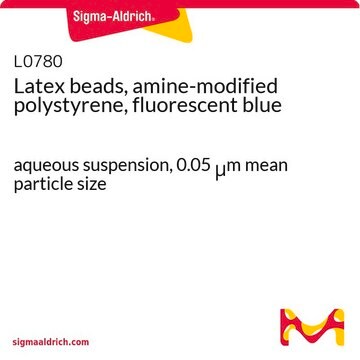66019
Nano beads based on polyacrylonitrile, Chromeon 642-marked, carboxylated
Synonym(s):
PAN-Chromeon 642, carboxylated
Sign Into View Organizational & Contract Pricing
All Photos(1)
About This Item
UNSPSC Code:
12352200
form
liquid
concentration
0.5%
average diameter
80-100 nm
fluorescence
λex 642 nm; λem 677 nm in H2O
storage temp.
2-8°C
Application
Nanobeads based on polyacrylonitrile, Chromeon 642-marked, carboxylatedis an effective vehicle for energy transfer with external fluorescent dyes and embedded dyes making them useful in FRET-based immunoassay applications such as protein nanoarray and quantum dot assays.
Storage Class Code
12 - Non Combustible Liquids
WGK
WGK 3
Flash Point(F)
Not applicable
Flash Point(C)
Not applicable
Personal Protective Equipment
dust mask type N95 (US), Eyeshields, Gloves
Certificates of Analysis (COA)
Search for Certificates of Analysis (COA) by entering the products Lot/Batch Number. Lot and Batch Numbers can be found on a product’s label following the words ‘Lot’ or ‘Batch’.
Already Own This Product?
Find documentation for the products that you have recently purchased in the Document Library.
Customers Also Viewed
R Bruck et al.
Biosensors & bioelectronics, 26(9), 3832-3837 (2011-03-23)
We report the development of a Mach-Zehnder interferometer biosensor based on a high index contrast polymer material system and the demonstration of label-free online measurement of biotin-streptavidin binding on the sensor surface. The surface of the polyimide waveguide core layer
Hye-Young Park et al.
Langmuir : the ACS journal of surfaces and colloids, 26(10), 7327-7333 (2009-12-25)
The generation of compact quantum dots (QDs) probes is of critical importance for visualizing molecular interaction occurring in biological context, particularly when using the Förster resonance energy transfer (FRET) approach. This Article reports novel water-soluble compact CdSe/ZnS QDs prepared by
Phat L Tran et al.
Analytical and bioanalytical chemistry, 398(2), 759-768 (2010-07-24)
An alternative approach for fabricating a protein array at nanoscale is suggested with a capability of characterization and/or localization of multiple components on a nanoarray. Fluorescent micro- and nanobeads each conjugated with different antibodies are assembled by size-dependent self-assembly (SDSA)
Our team of scientists has experience in all areas of research including Life Science, Material Science, Chemical Synthesis, Chromatography, Analytical and many others.
Contact Technical Service
